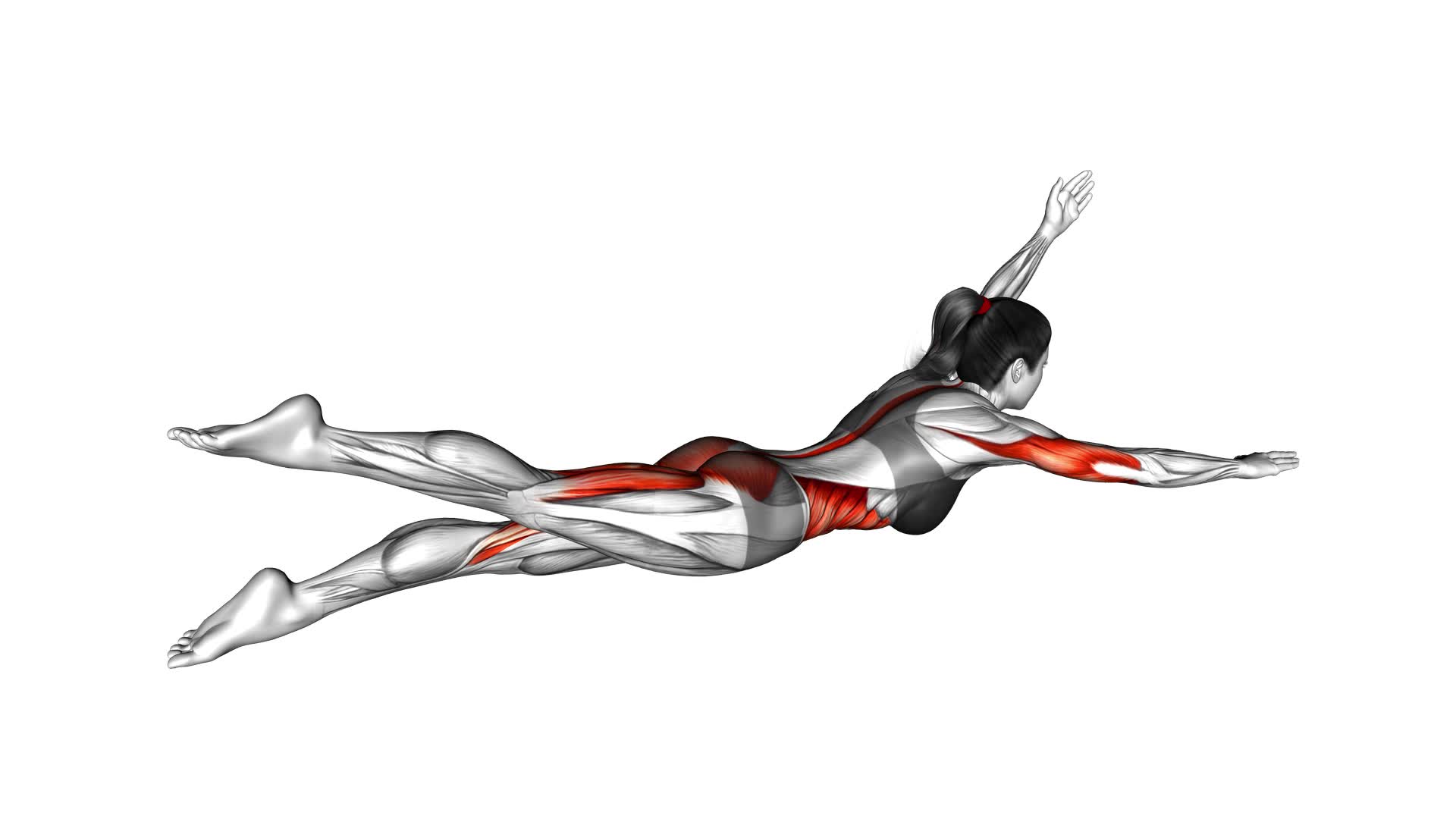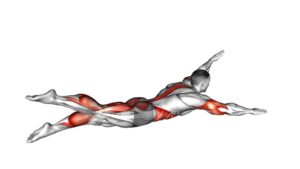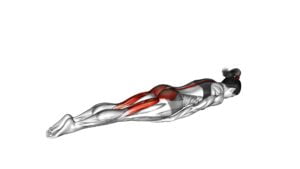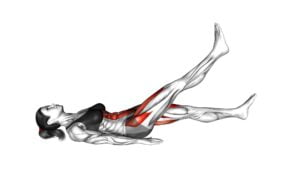Swimmer Kicks (VERSION 2) (female) – Video Exercise Guide & Tips

Are you ready to take your swimmer kicks to the next level?
Watch This Exercise Video
In this video exercise guide, we'll show you how to perfect your form and technique. Whether you're a beginner or looking to switch things up, we've got you covered with variations and modifications.
Get ready to challenge your core and lower body muscles with this effective workout.
It's time to dive in and make a splash with your fitness routine.
Key Takeaways
- Swimmer kicks improve lower body strength and endurance, targeting leg muscles and enhancing overall physical fitness.
- Proper form and technique include keeping legs straight and together, initiating movement from the hips, and maintaining a steady and controlled pace.
- Various drills and exercises, such as kickboard drills, scissor kicks, and dolphin kicks, can be used to improve swimmer kicks and enhance swimming ability.
- Swimmer kicks can be modified by using ankle weights, holding a medicine ball or dumbbell between feet, or performing on a stability ball, and can be incorporated into a workout routine to warm up, activate leg muscles, improve swimming performance, and increase endurance.
Benefits of Swimmer Kicks
Swimmer kicks can significantly improve your lower body strength and endurance. Not only do they target and strengthen your leg muscles, but they also have a positive impact on your cardiovascular fitness. By incorporating swimmer kicks into your workout routine, you can effectively enhance your overall physical fitness.
These kicks specifically focus on engaging the muscles in your legs, including your quadriceps, hamstrings, and glutes. By repeatedly kicking your legs in a controlled motion, you're effectively working these muscles and promoting their strength and endurance.
In addition to strengthening your leg muscles, swimmer kicks also provide a cardiovascular workout. They require a continuous and rhythmic motion, which increases your heart rate and improves your cardiovascular fitness. This can lead to improved stamina and endurance, allowing you to engage in physical activities for longer periods of time without becoming fatigued.
Whether you're a swimmer looking to enhance your performance in the water or someone simply looking to improve their overall fitness, incorporating swimmer kicks into your exercise routine can provide numerous benefits. Not only will they strengthen your leg muscles, but they'll also improve your cardiovascular fitness, helping you reach your fitness goals.
Proper Form and Technique
To perform swimmer kicks with proper form and technique, start by lying flat on your stomach in the water. This position allows for maximum engagement of the core and lower body muscles. Here are some key tips to ensure you're executing swimmer kicks correctly:
- Keep your legs straight and together, with your toes pointed.
- Initiate the movement from your hips, not your knees, to generate power and maintain fluidity.
- Alternate kicking your legs up and down in a flutter-like motion, while keeping your knees slightly bent.
- Maintain a steady and controlled pace, avoiding any jerky or rushed movements.
Proper form and technique are crucial to maximizing the benefits of swimmer kicks. By executing them correctly, you can target and strengthen your core, glutes, and legs, while improving your overall swimming performance. However, there are some common mistakes to watch out for:
- Splaying your legs or crossing them over each other, which can reduce the effectiveness of the exercise.
- Pointing your toes too much or flexing them too little, which can cause strain on the ankles.
- Using excessive force or kicking too forcefully, which can lead to fatigue and decrease efficiency in the water.
To improve your swimmer kicks, incorporate drills and exercises such as kickboard drills, scissor kicks, and dolphin kicks. These drills help develop strength, coordination, and endurance in your lower body, ultimately enhancing your swimming ability. Remember to always prioritize proper form and technique to get the most out of your swimmer kicks.
Variations and Modifications
To add variety and tailor the exercise to your specific needs, there are several variations and modifications you can incorporate into your swimmer kicks routine. These modifications can help target different muscle groups and intensify the workout.
One modification is to perform the swimmer kicks with ankle weights. This adds resistance and increases the challenge for your leg muscles.
Another modification is to do the swimmer kicks while holding a medicine ball or a dumbbell between your feet. This engages your core muscles even more and adds an element of stability training.
Additionally, you can try doing the swimmer kicks on a stability ball. This increases the instability and requires more core strength and balance.
If you're looking for alternative variations, you can try the flutter kicks. Instead of alternating legs, you keep both legs extended and kick up and down simultaneously. This variation primarily targets your lower abdominal muscles.
Another alternative variation is the dolphin kick. This is a more advanced version where you kick both legs together in a dolphin-like motion, engaging your core and lower back muscles.
Remember to always start with the basic swimmer kicks and gradually progress to the modifications and alternative variations as you build strength and technique. It's important to listen to your body and choose the variations that suit your fitness level and goals.
Tips for Beginners
If you're new to swimmer kicks, it's important to regularly practice this exercise to build strength and improve technique. Here are some tips to help you get started:
- Focus on form: One common mistake beginners make is sacrificing form for speed. Remember to keep your legs straight and toes pointed, while engaging your core and glutes. This will ensure that you're getting the most out of the exercise and preventing any potential injuries.
- Start slow: It's important to start at a comfortable pace and gradually increase your speed as you become more comfortable with the movement. Rushing into fast kicks can lead to poor form and decreased effectiveness.
- Use proper breathing: Many beginners forget to breathe properly while performing swimmer kicks. Remember to inhale deeply as you extend your legs and exhale as you bring them back towards your body. This will help you maintain a steady rhythm and maximize your oxygen intake.
- Don't overdo it: While it's important to practice regularly, it's equally important to listen to your body and avoid overexertion. Start with shorter sets and gradually increase the duration and intensity as you progress. Pushing yourself too hard too soon can lead to fatigue and muscle soreness.
Incorporating Swimmer Kicks Into Your Workout Routine
Now that you have mastered the technique and gained strength with swimmer kicks, it's time to incorporate this exercise into your regular workout routine. Swimmer kicks are a great way to improve your leg strength and overall swimming performance.
To get started, consider incorporating swimmer kicks into your warm-up routine before swimming laps. This will help activate your leg muscles and prepare them for the different types of swimming strokes you'll be performing.
To increase your swimmer kick endurance, gradually increase the duration and intensity of your kicks. Start by performing short sets of 30-second kicks, and then gradually increase the time to 45 seconds, and eventually up to a minute or longer.
Additionally, you can incorporate intervals into your swimmer kick routine. For example, alternate between fast and slow kicks for a certain number of repetitions. This will help build both strength and endurance in your leg muscles.
Remember to maintain proper form throughout your swimmer kicks. Keep your legs straight and engage your core muscles to maximize the effectiveness of the exercise. As with any exercise, listen to your body and take breaks as needed.
Incorporating swimmer kicks into your workout routine won't only improve your leg strength and endurance but also enhance your overall swimming performance.
Frequently Asked Questions
How Many Calories Can You Burn by Doing Swimmer Kicks?
Swimmer kicks can be a great exercise for burning calories. By incorporating swimmer kicks into your workout routine, you can engage multiple muscle groups and increase your heart rate, resulting in more calories burned.
This technique involves lying on your stomach and kicking your legs in a fluttering motion, mimicking the movement of swimming. In addition to burning calories, swimmer kicks can also improve your core strength and cardiovascular endurance.
Can Swimmer Kicks Help Improve Flexibility?
Swimmer kicks can definitely help improve flexibility.
By engaging your leg muscles and performing the kicking motion, you're stretching and lengthening the muscles in your lower body.
This dynamic movement targets the hamstrings, quadriceps, and hip flexors, promoting increased range of motion and flexibility.
Incorporating swimmer kicks into your workout routine can be a beneficial addition to your stretching exercises, helping you maintain and improve your overall flexibility.
Are There Any Common Mistakes to Avoid While Doing Swimmer Kicks?
When doing swimmer kicks, it's important to avoid common mistakes to ensure you're using the proper technique. Some mistakes to watch out for include:
- Bending your knees too much
- Kicking too forcefully
- Not keeping your core engaged
By avoiding these errors, you can maximize the benefits of swimmer kicks and improve your flexibility effectively.
Remember to focus on maintaining proper form throughout the exercise for optimal results.
Can Swimmer Kicks Help in Toning the Abdominal Muscles?
Swimmer kicks can definitely help in toning your abdominal muscles. By incorporating swimmer kicks into your workout routine, you can target and strengthen your core.
This exercise is particularly beneficial for providing lower back pain relief. The rhythmic kicking motion engages your abdominal muscles, helping to tone and sculpt them.
How Often Should Swimmer Kicks Be Performed to See Results?
To see results from swimmer kicks, it's important to perform them regularly. The frequency of your sessions will depend on your fitness goals and current level of fitness.
Generally, aim to do swimmer kicks 2-3 times a week. Each session should last about 15-30 minutes.
The intensity of your kicks can definitely affect the results. To maximize toning and strengthening of your abdominal muscles, focus on engaging your core and maintaining proper form throughout each kick.
Conclusion
Incorporating swimmer kicks into your workout routine can provide numerous benefits for your overall fitness.
By mastering the proper form and technique, you can engage your core muscles, improve your lower body strength, and enhance your endurance.
Additionally, there are variations and modifications available to cater to different fitness levels.
Whether you're a beginner or an experienced athlete, swimmer kicks can be a valuable addition to your exercise regimen.
Start incorporating them into your workouts today and experience the positive impact on your fitness journey.

Author
Years ago, the spark of my life’s passion ignited in my mind the moment I stepped into the local gym for the first time. The inaugural bead of perspiration, the initial endeavor, the very first surge of endorphins, and a sense of pride that washed over me post-workout marked the beginning of my deep-seated interest in strength sports, fitness, and sports nutrition. This very curiosity blossomed rapidly into a profound fascination, propelling me to earn a Master’s degree in Physical Education from the Academy of Physical Education in Krakow, followed by a Sports Manager diploma from the Jagiellonian University. My journey of growth led me to gain more specialized qualifications, such as being a certified personal trainer with a focus on sports dietetics, a lifeguard, and an instructor for wellness and corrective gymnastics. Theoretical knowledge paired seamlessly with practical experience, reinforcing my belief that the transformation of individuals under my guidance was also a reflection of my personal growth. This belief holds true even today. Each day, I strive to push the boundaries and explore new realms. These realms gently elevate me to greater heights. The unique combination of passion for my field and the continuous quest for growth fuels my drive to break new ground.







